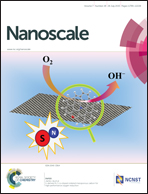Oxidative addition of the C–I bond on aluminum nanoclusters†
Abstract
Energetics and the in-depth reaction mechanism of the oxidative addition step of the cross-coupling reaction are studied in the framework of density functional theory (DFT) on aluminum nanoclusters. Aluminum metal in its bulk state is totally inactive towards carbon–halogen bond dissociation but selected Al nanoclusters (size ranging from 3 to 20 atoms) have shown a significantly lower activation barrier towards the oxidative addition reaction. The calculated energy barriers are lower than the gold clusters and within a comparable range with the conventional and most versatile Pd catalyst. Further investigations reveal that the activation energies and other reaction parameters are highly sensitive to the geometrical shapes and electronic structures of the clusters rather than their size, imposing the fact that comprehensive studies on aluminum clusters can be beneficial for nanoscience and nanotechnology. To understand the possible reaction mechanism in detail, the reaction pathway is investigated with the ab initio Born Oppenheimer Molecular Dynamics (BOMD) simulation and the Natural Bond Orbital (NBO) analysis. In short, our theoretical study highlights the thermodynamic and kinetic details of C–I bond dissociation on aluminum clusters for future endeavors in cluster chemistry.


 Please wait while we load your content...
Please wait while we load your content...